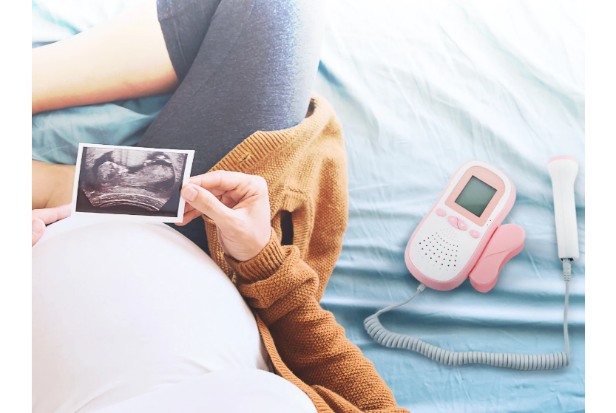In this article, we’ll show you how to locate the sound of a fetal heartbeat using a doppler and listen to it correctly.
It can be magical to hear your baby’s heartbeat for the first time. Many people enjoy hearing the first lub-dub as quickly as they can. Consequently, you can easily hear your unborn child’s heartbeat using a fetal doppler. Fetal dopplers are widely accessible, and you can check while listening to the heartbeat. However, because this doppler is unable to transmit background noise, it will be difficult for you to hear your baby’s heartbeat, which is the most precious sound.
What is a Fetal Doppler?
A fetal doppler, or a fetal heartbeat doppler, is a small hand-held device that you use to hear your baby’s heartbeat while they’re still in the womb.
A fetal doppler works by running a probe on top of ultrasound gel along your belly, similar to an ultrasound device that you’d see in your OBGYN’s office.
Depending on the fetal doppler model you’re using, you might be able to hear the baby’s heartbeat through the gadget’s built-in speaker or you might need to wear headphones.
Why Do Expectant Mothers Love Using a Fetal Doppler?
The benefits of using a fetal doppler include:
- Dopplers for the womb improve maternal and infant bonding.
- Between checkups, fetal dopplers give peace of mind (important note: using a fetal doppler does not take the place of your scheduled medical appointments).
- Before the big arrival day, fetal dopplers make it easier for family and friends to get to know their new family member.
- Fetal dopplers are a wonderful way to help fathers form bonds with their new babies before they are born and to help children meet their new siblings.
Top Tip: A wonderful gift for a pregnant woman is a fetal doppler. Additionally, we have a variety of fetal doppler models so that every family and every budget can find the ideal option. Shop here
Are Fetal Dopplers Safe to Use?
There are differences in fetal doppler quality, so it’s important to take that into account.
There is no better pregnancy partner than the BabyHeart Fetal Doppler Monitor when it comes to the health and security of your unborn child. Due to our position as market leaders, we offer the broadest range of ARTG-registered baby fetal doppler products.
With the help of our cutting-edge product, you can keep track of your baby’s heartbeat throughout pregnancy, giving expecting parents, their friends and families, and everyone else peace of mind and happy memories.
Fetal dopplers made by BabyHeart use ultrasound waves that are considerably weaker than those produced by an ultrasound, making them completely safe to use as instructed for brief periods of time.
When Do Babies First Form a Heartbeat?
Researchers today pinpoint 22 days as the earliest parents-to-be can detect a heartbeat. Because fetuses don’t have lungs when they are developing, their circulatory systems are built differently while inside the womb. Instead of the full-fledged circulatory system you’d recognize in a fully-grown human, the blood is circulated through a system of shunts.
There are two important features of the fetal heart to be aware of:
- The foramen ovale, an open flap between both chambers of the heart which shuts after your baby is born
- The ductus arteriosus, a major blood vessel which, after birth, will be replaced by the aorta and pulmonary artery to connect with your newborn’s lungs
What does this entail for upcoming mothers? It implies that at 22 days old, your baby’s heart is still nothing more than a collection of cells.
So, while you may be able to sonically hear your little one’s heartbeat with a fetal heart rate monitor, it’s essential to keep seeing your doctor to confirm your baby is developing at a healthy rate.
What is a Fetal Doppler?
Similar to an ultrasound imaging machine, a fetal doppler, also known as a fetal heart rate monitor, is a general term for a device that detects a heartbeat through sound waves. By measuring the change of frequency in sound waves from an echo (also known as the Doppler effect), a fetal Doppler imitates the tiny heartbeat of your child.
There are two types of Fetal Doppler devices you may encounter while pregnant:
- Clinical Fetal Doppler – Clinical fetal Dopplers are sophisticated, sensitive devices that are frequently found in hospitals. They typically feature 3D (or even 4D) imaging and stronger soundwave currents. At your second routine ultrasound appointment (18 to 20 weeks), first prenatal appointment (around 8 weeks), or during the first few hours of labor, your OBGYN might advise using this device.
- At-Home Fetal Doppler – Fetal doppler devices for home use are less advanced than those used in hospitals. But that doesn’t mean they’re not worth your time or money! They can be a great tool for establishing a connection with your infant while you are at home if used properly.
Fetal dopplers you can use at home are a great way to monitor your unborn child’s development between trips to the doctor’s office and a deeper connection with your child. Just remember that these baby heart rate monitors should always be used to complement, rather than replace, in-person appointments with your healthcare provider.
When Should You Start Using a Fetal Doppler?
A fetus’ heart is known to begin beating at around 22 days, but you won’t be able to tune your baby’s heartbeat at this stage using an at-home heart rate monitor.
So, when can fetal doppler devices detect a baby’s heartbeat? The majority of Fetal Dopplers work best when used in your second or third trimesters, when your baby’s heartbeat is strong enough to register.
That said, there is a pattern to baby heartbeat formation, and, correlatively, how early fetal heartbeat can be detected with clinical or at-home Dopplers:
- Week 5 – Your baby’s heart begins to beat as a single, cohesive structure a little after one month. However, fetal Dopplers will not pick up this sound because they are used transabdominally (by being placed against the mother’s abdomen). A heartbeat this faint at this stage can only be seen using vaginal ultrasounds.
- Weeks 6 to 8 – During this period, your baby’s heartbeat will rise from 110 bpm (beats per minute) to 150 to 170 bpm—about twice as fast as yours. A clinical fetal doppler may now be able to hear your baby’s heartbeat.
- Week 10 – Most infants’ hearts are beating at 170 beats per minute by this point. It will decrease to about 140 bpm between now and week 20. Most high-quality fetal dopplers won’t function properly until at least week 16 of your pregnancy, despite the claims of some at-home models, which claim to be able to detect your baby’s heartbeat at this point. Before purchasing and using your device, if in doubt, speak with your OBGYN.
- Week 12 – Your OBGYN should have scheduled or finished your first trimester check-in by week 12 to ensure your baby’s heart is beating. Why? According to research, a baby has a 99.4% chance of surviving a miscarriage if its heartbeat is discovered after week 10.
How to Use a Fetal Doppler, Step by Step
Before speaking to your child, you need to take a few practical steps. So how can a pregnant woman at home check her baby’s heartbeat?
Before you begin, set up a station with your Fetal Doppler, batteries for your device, and these three essentials:
- Fetal Doppler gel – Fetal Doppler or ultrasound gel is formulated with water and a solvent known as propylene glycol. It serves two critical roles in the heart monitoring process:
- To lubricate your skin, making for a more comfortable experience
- a bond must be created between the apparatus and your womb in order to conduct sound waves and remove static output that might interfere with your results.
- Headphones or speakers – Have your preferred listening device close by so you can hear your loved ones’ heartbeats in HiFi whether you’re experiencing this magical moment alone or with them.
- A private spot to lie down – Before using a Doppler at home, you should locate a quiet, cozy place to lie down. Get comfortable; a couch, bed, or yoga mat are all suitable options. Finding the heartbeat can take a few tries at first.
It’s time to have that heart-to-heart after you’ve set up your station and are feeling composed. Bear in mind that every Fetal Doppler device is different, but most of them will require five basic steps to use:
- Get into a reclined position and turn on your fetal Doppler (and any other sound devices you’ve connected)
- To reveal your stomach, lift your shirt or sag your pants. Next, spread a generous amount of ultrasound gel over the lower abdomen.
- After placing it on top of the gel, slowly begin to move the device from the lower abdomen toward the navel. Repeat this motion using slow, continuous strokes, moving laterally to allow the device to access your uterus in a different location.
- Your headphones or speakers may sound slightly louder when your baby’s heartbeat is discovered, or your fetal doppler may visually indicate that your baby’s heartbeat has been located.
- When you’re done, remove the gel from the device and your stomach by wiping them down with a fresh washcloth or towel.
It’s common for expectant mothers to have some difficulty finding that tiny heartbeat on their first attempt. The maximum recommended duration for your baby listening sessions is ten minutes, so if you’re having trouble connecting, turn off your device after that time and try again later.

Our Top Tips for Finding Your Baby’s Heartbeat Using a Fetal Doppler
Tip 1: Don’t Skimp on the Gel!
If you’ve ever had an ultrasound, you might remember that the technician will generously apply ultrasound gel. This is because the gel makes it simpler for the device to detect a heartbeat. Static, which otherwise might interfere with the signal, is reduced by ultrasound gel.
Not to worry, BabyHeart Australia has thought of everything and many of our fetal dopplers include a FREE full-size bottle of ultrasound gel.
Application Tip: Avoid massaging the ultrasound gel into your lower belly like you would a moisturizer; instead, gently apply it in a layer.
Tip 2: Have a Full Bladder
Why not try getting out of bed first thing in the morning and, before you use the bathroom, see if you can find your little one’s heartbeat? Many women find that the first hour or so of the day is the most productive time for locating the baby’s heartbeat.
The sound can be heard more clearly in this position because having a full bladder helps to push your uterus out of the pelvic cavity.
Tip 3: Don’t Rush
We are aware that trying to locate your baby’s heartbeat can be extremely exciting, so it can be tempting to move the probe around as much as you can if you are initially unsuccessful. But consistency is the key to winning the race.
It’s best to place the probe near the middle of the pubic bone region and then move up the belly in a gentle rocking motion, moving as slowly and steadily as you can.
Keep in mind that your doppler can also pick up on other sounds. By going slowly and gently angling the probe by rocking it as you move, you’ll have the best chance of finding your baby’s heartbeat using a doppler.
Tip 4: Know the Difference Between Your Heartbeat and Baby’s Heartbeat
Sometimes, fetal dopplers can detect the mother’s heartbeat. Can’t decide which is which? It’s a good rule of thumb to assume that your own heartbeat is present if the heartbeat is between 60 and 80 beats per minute.
The typical heartbeat of a fetus is between 120 and 180 beats per minute.
Recall that other factors, such as caffeine or nicotine, can also affect heart rate; this is only a general guide.
Tip 5: Know What Other Sounds to Look Out For
You’ll hear a variety of other sounds when using a doppler, but one of the most frequent sounds is a “whooshing” noise. This is typically audible when your belly moves or when you pass the placenta.
Your baby’s heartbeat is different from the whooshing sound.
There are times when you may also hear what appears to be two heartbeats at once, but this is usually an echo and does not mean that there are two heartbeats present (unless your doctor has said you have multiple babies).
Tip 6: Try Finding Your Own Heartbeat First
If you’re unsure of what sounds to listen for, you might want to place the doppler probe over your chest and listen to your own heartbeat.
This will clarify what you should be hearing and show you how to distinguish between your own heartbeat and that of your infant. Additionally, it will confirm the functionality of your fetal doppler.
Tip 7: Change Positions
While lying comfortably on your back is the position in which you’re most likely to hear your child’s heartbeat, if doing so makes you uncomfortable, try a different one.
You’ll feel more at ease if you’re more at ease.
TIP 8: Don’t Freak Out
Expecting desired results right away is unrealistic. It’s possible that you’ve grown accustomed to hearing your baby’s heartbeat, so when you suddenly can’t, you probably start to fuss. Many women believe that God forbids any problems with the unborn child or that the culprit is the technology.
In reality, there are many likelihoods behind not getting the heartbeat, like
- Your bladder is emptied.
- Your baby has moved into a position where it is hard to hear his heartbeat.
- You’re not lying down correctly. The recommended position is to recline so that the uterus is vertical.
- Do not use the doppler while standing.
- You might be applying too much gel. Be kind, but not excessively so. By generating air bubbles, using lots of gel can reduce static charges.
Avoid jumping to conclusions too soon. There is nothing to worry about if your baby is active.
But if you’re not seeing any progress, see a doctor right away.
TIP 9: Take the Heart Rate Range into Consideration
Moms occasionally hear their heartbeat rather than the babies’. Here’s how you can check the heart rate range;
- 60-80 BPM (Beat Per Minute) means it’s your heartbeat.
- 120-180 BPM (Beat Per Minute) shows that it’s the little ones.
The baby’s heartbeat will beat more quickly than your own, you’ll notice. It’s likely that you hear a faint heartbeat, but there’s no need to be alarmed. Slow heartbeats indicate that your child is simply having fun while changing positions.
TIP 10: Study the Sounds
Women frequently experience anxiety due to not hearing the heartbeat. Self-education regarding the heartbeat will be beneficial. On YouTube, there are a ton of videos that explain how to hear a baby’s heartbeat and distinguish it from your own.
Other Tips for Using a Fetal Doppler to Find Your Baby’s Heartbeat
Always double-check your health with your doctor before drawing any conclusions if you’re having trouble finding your child’s heartbeat because an at-home doppler doesn’t replace regular checkups in any way.
If you’re having trouble locating the heartbeat, taking a brief break may be beneficial. It might be too early or your baby might be in an unfavorable position for you to hear their heartbeat; take five, take some time to unwind, and try again later.
Keep your doppler’s probe clean as well because a buildup of ultrasound gel can make it more challenging to locate the heartbeat. After every use, always wipe your device clean.
Contact your doctor as soon as possible if you think something is wrong.
Where Do I Buy a Fetal Doppler?
The best place to buy a fetal doppler is right here at BabyHeart Australia. Here, you’ll find a variety of fetal heartbeat monitors with different options to suit your needs.
LCD displays and built-in vs. separate speakers are some of the model differences. headphones and other advanced features, so take a moment to consider your needs and what you might like in a device.
Our fetal dopplers at BabyHeart Australia are certified by the Australian Register of Therapeutic Goods, giving you peace of mind that they have been tested to the highest industry standards.
Additionally, we proudly provide a money-back guarantee and have trained customer service representatives available if you have any questions about the model to select.
Summary
Fetal Dopplers used at home do not appear to be harmful. It is reasonable to assume that using them excessively can result in a problem because of the risk that the heat they produce to the infant.
If a person is worried about the health of the unborn child, they should talk to a reputable doctor or midwife about coping mechanisms as well as any worries and risk factors.
The best course of action is to avoid using these devices, even when people are extremely concerned about the health of a developing baby. By doing this, risk will be reduced.



